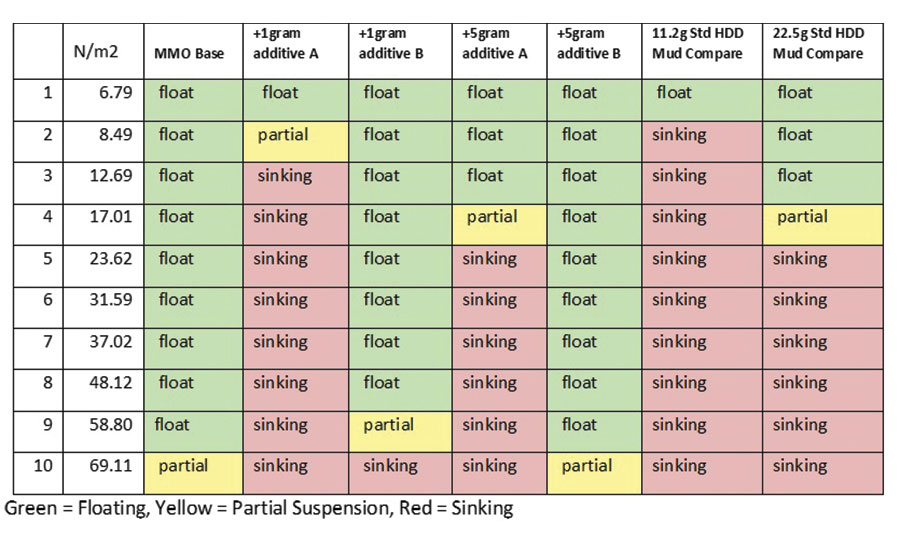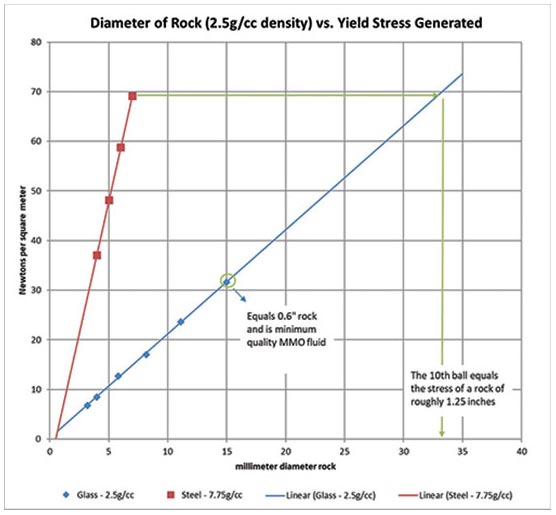In last month’s column, we started a look at mixed-metal hydroxide (MMH) fluids. That column looked at the different types, proper mixing, and started talking about ways to evaluate it. Refer to that issue (A Primer on Mixed-Metal Fluid Systems, February 2020) for the first part of the discussion that continues here. This column goes over a few more ways to evaluate MMH fluids, and touches on troubleshooting when contractors don’t get the results they want.
Fann Rheometer
Last month, I mentioned that the Fann rheometer is not much use in evaluating a mixed-metal type slurry. This statement does not tell the whole story though. The truth is that for most people (especially in the field), the Fann will not be of much use. Mixed-metal fluids behave strangely in traditional rheometers. It is nearly impossible to get a stable reading in a well-designed M-M fluid because the values at each speed will continue to drop for several minutes until the data tells you that your fluid is much, much thinner than what you see with your own eyes. This “dropping” effect is most pronounced at 3 and 6 rpms, and again at 300 and 600 rpms. I don’t know why V100 and V200 don’t show the same decreases.

The fact that we see this drop in rheometer values is very useful to someone who has experience looking for it. Aside from suspension, this viscosity dropping behavior is the one trait that I most use to evaluate an MMO fluid, but I do not recommend that you rely on this in the field. First, the actual rheology values will never match up day to day. Second, the most important speeds — 3 rpms and lower — are not available on most field-type Fann rheometers. It really requires the operator to take two readings at each speed: the one it reads at initially and the one it reads at after a set amount of time has passed. For an example of how I record my readings, see the Fann Data Table (right). However, most operators find taking readings in this manner too much hassle and anyone else looking at the data finds it confusing.
Marsh Funnel
The Marsh funnel is probably the most widely used viscosity measurement tool in the drilling industry, and it is certainly the most misunderstood. I won’t wade far into this debate right now, but I can say that I find the Marsh funnel unhelpful in measuring the viscosity of a mixed-metal fluid.
For starters, a well-designed MMO or MMS fluid will not flow through the funnel long enough to fill a cup. Remember that, at rest, a mixed-metal type fluid behaves as a solid. When agitated or sheared, it flows. There is a critical weight-stress that allows the M-M fluid to flow. However, at a certain point after it starts, the gelation nature of this fluid overcomes the decreasing stresses of weight and it starts to drip then solidify inside the cone. I have seen people in the field vigorously shake the funnel to make the fluid pour out to fill the cup, but that defeats the purpose, no? It’s best to put the Marsh funnel down when dealing with MMO slurries.
Shearometer
The shearometer can evaluate an M-M fluid, but requires the use of quite a bit of extra weight. The 5-gram aluminum cylinder typically supplied is simply too light to sink in a mixed-metal fluid. There are 20-gram cylinders available, as well as additional weights. These greatly expand the usefulness of the shearometer. However, operators will need to develop some sense as to how to conduct their own readings.
In general, I find this piece of equipment too fiddly to use in the field owing to the fact that you need to balance weights and use a ruler to measure sinking distances. A simple, good/bad test is preferable for field use.
Ball Harp
This is my personal favorite tool for the evaluation of mixed-metal fluids. However, finding one for sale may prove difficult. A ball harp functions like a shearometer in that it suspends a weight in a fluid. The advantage comes from a more rock-like shape and density (with increased surface area) for the suspended weights. It features 10 weighted balls suspended by strings around a disk. The first six, made from a glass-type material, have a density similar to native rocks (although they are smooth). Balls seven through 10 are steel and much denser. The spheres increase in effective yield stress as they progress up the scale.
I record balls as floating (on the surface), sinking (taught line under surface) and partially suspended (under surface, but with slack line). You can then color code the results — green for floating, yellow for partial suspension and red for sinking — and see trends on tables and graphs, as shown.


The balls and disk detach from the heavy stand and base for use by hand. This makes it a lot more portable. Operators can also order the balls and disk separately from the stand, which keeps costs down. One simply dips the balls into a Marsh-cup full of MMO mud and records floaters, sinkers and those in-between.
A good-quality MMO fluid can suspend at least the first six balls. The best quality ones (like the mix I suggested) will suspend at least the first nine and, many times, the 10th as well. If your MMO fluid cannot suspend at least the first six, then you have a bad MMO fluid with suboptimal performance.
Suspension Weights
Use of a suspension weight is absolutely the easiest way to evaluate an M-M system in the field. This can be as simple as setting a rock down on top of your fluid — essentially the same as the ball harp, but without the calibration. I have tied and glued fishing line to my set of rocks to aid in retrieving them, and recommend this slight modification if you want to have reproducible and comparable data.
As you can see in the photograph, a great mixed-metal system can easily suspend a rock well over 1-inch across. The mix shown used 3.4% w/w of API 13A Section 10 bentonite with 0.28% mixed-metal oxide.
Most systems run in the field use a treated bentonite, which needs a bit of tweaking to find the ideal dosage. I like to recommend good old-fashioned marbles as a good/bad delineation method. A standard glass playground marble has a nearly identical size, shape and density as ball number six on the ball-harp. If you remember, this is the minimum-sized ball that we want to suspend. Using a marble in a sink/float type test is a fantastic way of determining if you need to add more bentonite and MMO or not.
A similar test involves placing several marbles in a clear, narrow tube and pouring in your mixed-metal fluid. Cap the ends securely and shake the cylinder. You should clearly hear the marbles clacking around against each other and against the sides. Stop shaking. The marbles should be visible, suspended in the fluid. This also makes a great demo for customers since it shows both how the fluid thins and how it instantly sets up. You can get marbles and polished rocks at many craft and mega-stores.
The Solution
If for whatever reason, you find yourself with an M-M fluid that does not behave like it should, the good news is that you can fix most problems with patience, materials and more shear.
Anionic additives like PAC, xanthan, PHPA and polyacrylates will hurt a mixed-metal system. Avoid these if you can. If you cannot avoid using an anionic additive (say, if it is part of your bentonite) you need to compensate by adding more bentonite and likely more mixed-metal additive. For example, when using a 200+ barrel/ton high-yield product like SuperGel-X or Quik-Gel, it is often necessary to add an extra 100 pounds of bentonite and an extra 12 to 13 pounds of MMO for each 1,000 gallons of fluid. For highly treated products like Tru-Bore or Hydraul-EZ, it may be necessary to add even more mixed-metal additive on top of this — up to double the amount needed for an untreated API 13A Section 10 bentonite.
Second, higher shear and longer shearing time always help. In many cases, it is possible to convert a failing mixed-metal system to one that works beautifully by letting it age overnight and then turning the tank over a few times in the morning.
With a few tricks and some simple field-testing modifications, a mixed-metal fluid system could help you complete your next river-crossing or gravel-drilling job. People never like changing the way they do things, but if it can save time, money and headaches, a bit of change can improve your bottom line.




Report Abusive Comment